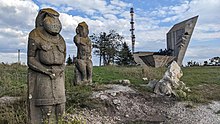Izium
It has held economic significance for centuries due to its position as a transportation link between Kharkiv and the Donbas region to the southeast.
The area around Izium has been periodically inhabited since ancient times, but the modern city has its origins in a 17th-century fortress defending against Tatar raids.
Izium was the site of several battles during World War II, but still grew rapidly during the 20th century due to its importance as a transport hub.
In the 12th century AD Kievan Rus began to disintegrate, leading to increased incursions by Cuman nomads.
In the year 1111, the territory that is now modern Izium was the site of the Battle of the Salnytsia River [uk], in which the East Slavs, led by Vladimir II Monomakh and Sviatopolk II of Kiev, defeated a Cuman army on the Salnytsia [ru] river.
As the Principality of Moscow evolved into the Tsardom of Russia, there was an effort to secure the southern border of the East Slavic lands, to stop the "devastating" attacks by the Crimean Tatars.
Markin notes that it would have probably been impossible to grow grapes in the area, making such a name illogical, and argues that such a word "huzun" meaning "raisin" does not exist in any Turkic language.
[6] In 1765, after the Izium Regiment was converted into a regular Russian hussar regiment as part of the abolition of the Cossack system in Sloboda Ukraine, Izium received city status and was assigned to Sloboda Ukraine Governorate of the recently-proclaimed Russian Empire.
Izyumsky Uyezd was originally a subdivision of Kharkov Viceroyalty in 1780, but was transferred to the reformed Sloboda Ukraine Governorate in 1796.
[15] In 1916, in accordance with an edict by Tsar Nicholas II, the construction of an optical glass plant began in Izium.
As a result of the Holodomor, a manmade famine in Soviet Ukraine between 1932 and 1933, 2,761 people from Izium are documented to have died.
[23] Izium's population grew rapidly in the 20th century due to its importance as a junction between Kharkiv and the Donbas.
[27] Deutsche Welle (DW) reported in April 2014 that during the 2014 pro-Russian unrest in Ukraine, there was only one attempt to hoist the Russian flag on any government buildings in Izium.
A local government official said that out of the approximately 50,000 inhabitants, Izium had "a maximum of 200 active pro-Russian people".
[28] Izium was seen as an important link between separatist-held Sloviansk and Kharkiv, which also had active pro-Russian movements, and there were fears that separatists would move in that direction.
[26] During Ukraine's Siege of Sloviansk to reclaim it from the separatists, Izium was used as a base for operations by the Ukrainian military.
[29] Large-scale fighting in the proximity of Izium halted once Ukrainian forces liberated Sloviansk in July 2014.
The director of the school was one of the residents of Izium accused of collaborating with Russia, and would later be put on trial in Kharkiv by Ukraine after the end of occupation.
According to the British Ministry of Defense, Ukrainian forces rebuffed the attempted river crossing with substantial Russian losses.
[37] The June 2022 shooting of Andrii Bohomaz by Russian soldiers in Izium during the occupation was featured in Lubomir Levitski's documentary Follow Me.
[37] After Ukrainian troops secured the liberated city, local police officers found mass graves of 440 bodies in Izium.
[45] In September 2023, a year after the end of Russian occupation, Izium was still scarred and its people traumatized by war.
The hospital still bore heavy damage from a missile strike, and urgent surgeries were held in a "small, dank room in the basement" due to fear of Shahed drone attacks.
"[37] Izium is located at the foot of the Kremenets [uk] Mountain, on the right bank of the Donets river.
[48] The factories of Izium produce optical equipment, mechanical components, concrete products, building materials, and foodstuffs.





